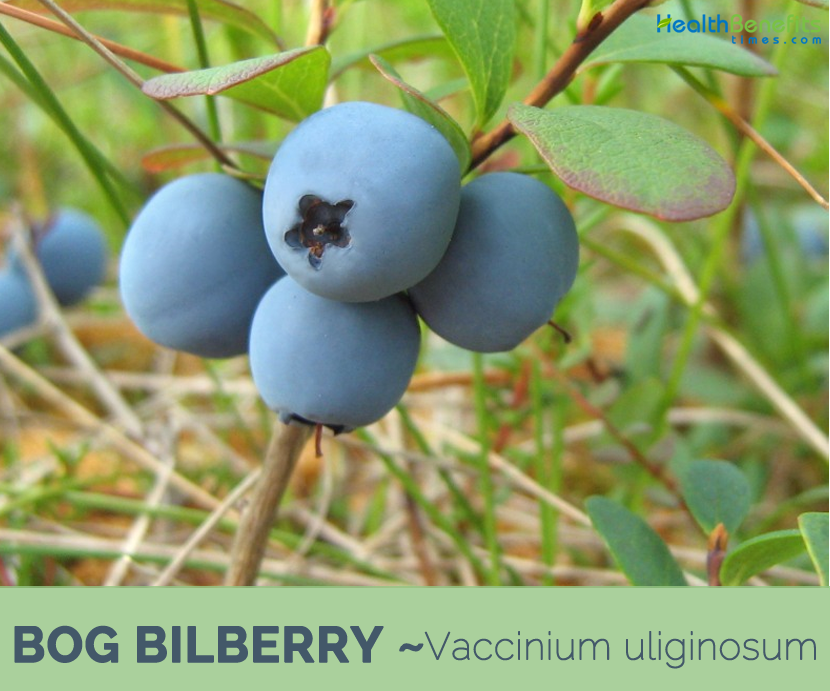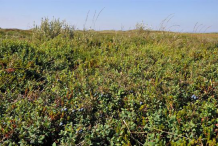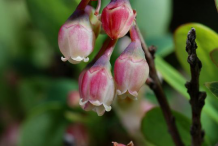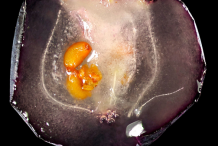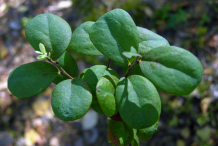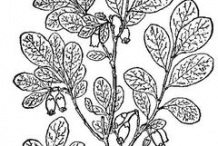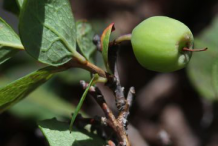Plant Description
Bog Bilberry is a low, highly branched, deciduous shrub that grows about 10–75 centimeters (0.33–2.46 ft.) tall, rarely 1 meter (3.3 ft.) tall with round, gray-brown, glabrous branches and a creeping rhizome. The plant is found growing in coastal and interior bogs, cotton grass tussock tundra, low shrub tundra, sedge meadows, black or white spruce woodlands, forested areas, rocky or sandy shores of lakes and streams, rock outcrops and barrens. The plant prefers organic or inorganic soils that are generally acidic and is found growing abundantly on well-drained to poorly drained sites. The plant has many green, triangular, erect stems and twigs are slender. Older twigs have gray, shreddy bark.
Leaves
Leaves are alternate, deciduous, from broadly egg-shaped to oval or elliptic, 0.4-3 cm long, 0.2-1.5 cm wide, rounded at tips, tapered at base, glabrous or minutely hairy, with slight bloom, strongly net-veined, margins entire, rolled under somewhat. The undersurface has a protruding, reticulate vein system and is blue-green. The upper surface of the leaves is light matte-green to almost white.
Flower & Fruit
The flowers are arranged in axils of small leaves at the end of short lateral branches. They are hanging and white or reddish in color. The pedicle is encircled at the base with a light brown bud husk. The calyx is fused with the ovary. The fruit is a round or pear-shaped, blue-frosted multi-seeded dark blue-black berry 5–8 millimeters (0.20–0.31 in) diameter, with a white flesh, edible and sweet when ripe in late summer. The light brown seeds are sickle-shaped with sharp ends, and have a punctate-reticulate skin.
Few Traditional uses and benefits of Bog Bilberry
- An infusion of the leaves and sugar has been given to a mother a few days after childbirth in order to help her regain her strength.
- Bog Bilberry is used for gastric and intestinal catarrh, diarrhea and bladder complaints.
Culinary Uses
- Bog blueberries are edible and have good flavor.
- Berries are often picked in large quantities and used in jams, jellies, and pies.
- Fresh or dried leaves can be used for tea.
- The fruit can also be dried and used like raisins.
- A tea is made from the leaves and dried fruits.
- In Korea, bog bilberry is used in infused liquor.
Precautions
- The fruit can cause headaches if they are eaten in large quantities.
- Consumption of large quantities of the fruits may results in queasiness, vomiting, states of intoxication, feelings of weakness and visual disorders.
References:
https://www.itis.gov/servlet/SingleRpt/SingleRpt?search_topic=TSN&search_value=23574#null
https://davesgarden.com/guides/pf/go/95606/
https://npgsweb.ars-grin.gov/gringlobal/taxonomydetail.aspx?id=41063
https://www.pfaf.org/user/Plant.aspx?LatinName=Vaccinium+uliginosum
http://www.floracatalana.net/vaccinium-uliginosum-l
http://www.theplantlist.org/tpl/record/tro-12300065
https://plants.usda.gov/core/profile?symbol=vaul
https://en.wikipedia.org/wiki/Vaccinium_uliginosum
Comments
| Bog Bilberry Quick Facts | |
|---|---|
| Name: | Bog Bilberry |
| Scientific Name: | Vaccinium uliginosum |
| Origin | temperate regions of the Northern HemisphereT |
| Colors | Green when young turning to dark blue-black as they mature |
| Shapes | Berry 5–8 millimeters (0.20–0.31 in) diameter |
| Flesh colors | White |
| Taste | Sweet |
| Name | Bog Bilberry |
|---|---|
| Scientific Name | Vaccinium uliginosum |
| Native | Cool temperate regions of the Northern Hemisphere, at low altitudes in the Arctic, and at high altitudes south to the Pyrenees, the Alps |
| Common Names | Alpine Blueberry, bog bilberry, bog blueberry, Northern Bilberry |
| Name in Other Languages | Arabic: وكب almanaqie (المناقع) Azerbaijani: Cır mərsin Bashkir: Ҡара көртмәле Belarusian: Bujaki (Буякі) Belarusian (Taraškievica): Дурніцы Buryat (Russia): Нэрhэн Catalan: Nabinera alpina Catalan, Valencian: Nabiu uliginós Chinese: De guǒ (地果), Diān guǒ (甸果), Dǔ sī (笃斯), Dǔ sī yuè jú (笃斯越桔), Há táng guǒ (蛤螗果), 讷日苏, Hēidòu (黑豆), Lóng guǒ (龙果), Dǔ sī yuè jú (笃斯越橘) Czech: Vlochyně bahenní Danish: Mosebølle (plante) Dutch: Rijsbes Dutch Low Saxon: Riesbees English: Bog bilberry, Bog blueberry, Moorberry, Western-huckleberry, Alpine Blueberry, Northern Bilberry, Bog whortleberry , Ground Hurts Estonian: Sinikas Finnish: Juolukka French: Airelle de marécages, Myrtille des marais German: Moosbeere, Rauschbeere, Sumpf-Heidelbeere, Trunkelbeere, bleuet traînard, myrtille de loup, Myrtille des marais Japanese: kuromamenoki Galician: Arandeira negra Icelandic: Bláberjalyng, Aðalbláber Japanese: Kuromamenoki ( クロマメノキ) Komi: Чӧдлач Korean: Dultdzugnamu (들쭉나무) Lithuanian: Vaivoras Northern Sami: Ehtemas Norwegian: Blokkebær Norwegian (Nynorsk): Blokkebær Norwegian Nynorsk: Blokkebær Ossetian, Ossetic: Къабузæг Ossetic: Къабузæг Polish: Borówka bagienna Russian: Golubika (Голубика) Sami (Northern): Ehtemas Spanish: arándano de los pantanos Swedish: Odon Turkish: Bataklık yaban mersini Ukrainian: Buyakhy (Буяхи) |
| Plant Growth Habit | Low, highly branched, deciduous shrub |
| Growing Climate | Coastal and interior bogs, cotton grass tussock tundra, low shrub tundra, sedge meadows, black or white spruce woodlands, forested areas, rocky or sandy shores of lakes and streams, rock outcrops, and barrens |
| Soil | Organic or inorganic soils that are generally acidic. Found on well-drained to poorly drained sites |
| Plant Size | 10–75 centimeters (0.33–2.46 ft.) tall, rarely 1 meter (3.3 ft.) tall |
| Twigs | Twigs are slender. Older twigs have gray, shreddy bark |
| Leaf | Alternate, deciduous, from broadly egg-shaped to oval or elliptic, 0.4-3 cm long, 0.2-1.5 cm wide, rounded at tips, tapered at base, glabrous or minutely hairy, green above, lower surfaces pale |
| Flower | Pendulous, urn-shaped, pale pink, 4–6 mm long, produced in mid spring |
| Fruit Shape & Size | Berry 5–8 millimeters (0.20–0.31 in) diameter |
| Fruit Color | Green when young turning to dark blue-black |
| Flesh Color | White |
| Seed | Light brown, sickle-shaped with sharp ends, and have a punctate-reticulate skin |
| Taste | Sweet |
| Plant Parts Used | Dried ripe fruit |
| Varieties/Types |
|


